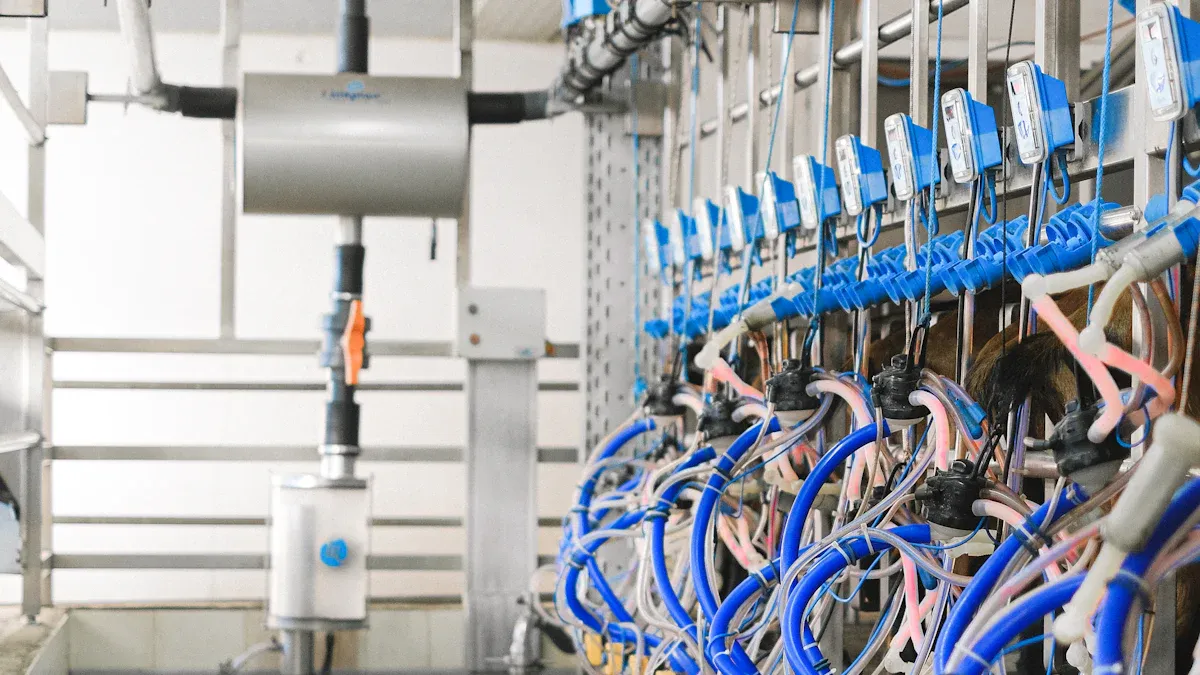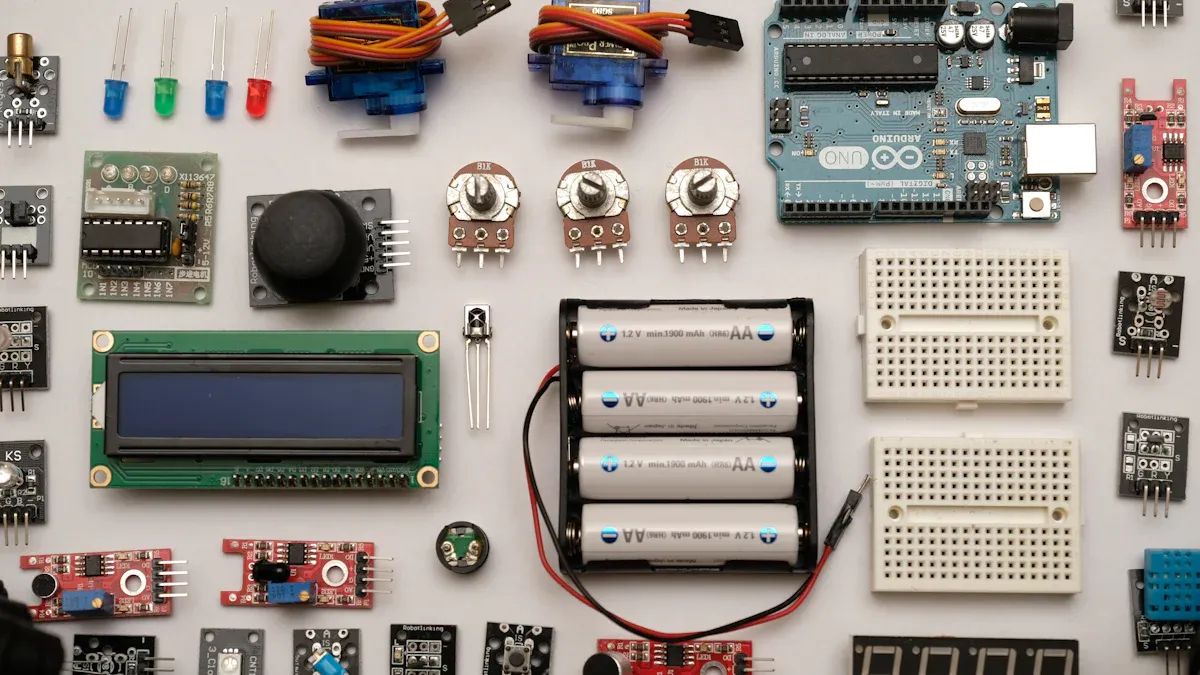
Industrial communication protocols form the backbone of modern factories, playing a crucial role in Industrial Telecom. These protocols enable machines and systems to share information in real time, ensuring smooth operations. Industrial Telecom relies on them for process automation, predictive maintenance, and quick decision-making. Real-time data exchange fuels the advancement of Industrial Telecom, driving smart manufacturing and making Industry 4.0 a reality.
Key Takeaways
- Industrial communication protocols help machines share data in real-time. This ensures smooth and effective operations.
- Protocols like Modbus and PROFINET make automation easier. They let devices share data fast and reliably.
- Real-time data sharing helps with important tasks like predicting problems and checking machines from far away. This reduces delays and saves resources.
Understanding Industrial Communication Protocols and Their Importance
Definition and Purpose of Industrial Communication Protocols
Industrial communication protocols are rules that allow devices and systems to exchange information. These protocols ensure that machines in factories can "talk" to each other effectively. Without them, devices would struggle to share data, leading to delays or errors. You can think of these protocols as a common language that all machines understand. They help maintain smooth operations by ensuring data flows correctly between different systems.
The Role of Protocols in Industrial Automation and Connectivity
In industrial automation, communication protocols play a vital role. They connect machines, sensors, and controllers, creating a network where everything works together. This connectivity allows you to automate processes, reduce manual work, and improve efficiency. For example, a protocol might enable a sensor to send temperature data to a controller, which then adjusts a machine’s settings. In Industrial Telecom, these protocols ensure that data moves quickly and reliably, supporting real-time decision-making.
Importance of Real-Time Data Exchange in Industrial Telecom
Real-time data exchange is essential for modern industries. It allows you to monitor operations, detect problems, and respond instantly. Industrial Telecom relies on this capability to support tasks like predictive maintenance and remote monitoring. For instance, if a machine shows signs of wear, real-time data can alert you before it fails. This reduces downtime and saves costs. By enabling real-time communication, protocols help industries stay competitive and efficient.
Key Industrial Communication Protocols and Their Features

Modbus: Simplicity and Wide Adoption
Modbus is one of the most widely used industrial communication protocols. Its simplicity makes it easy for you to implement and understand. Designed for serial communication, Modbus allows devices like sensors, controllers, and actuators to exchange data seamlessly.
Key Features of Modbus:
- Ease of Use: You can quickly set up Modbus without needing complex configurations.
- Compatibility: It works with various devices and systems, making it highly versatile.
- Master-Slave Architecture: The master device controls communication, while slave devices respond to requests.
Tip: If you’re looking for a protocol that balances simplicity and functionality, Modbus is a great choice for small to medium-sized industrial setups.
OPC UA: Interoperability and Scalability
OPC UA (Open Platform Communications Unified Architecture) stands out for its ability to connect diverse systems. It ensures interoperability, allowing you to integrate devices from different manufacturers into a single network.
Why OPC UA Matters:
- Scalability: You can expand your network as your operations grow without worrying about compatibility issues.
- Security: OPC UA includes built-in security features like encryption and authentication to protect your data.
- Platform Independence: It works across various operating systems and hardware platforms.
Note: OPC UA is ideal for complex industrial environments where you need to connect multiple systems and ensure secure communication.
PROFINET: High-Speed Communication for Real-Time Applications
PROFINET is designed for high-speed data exchange, making it perfect for real-time industrial applications. If your operations demand quick responses, PROFINET delivers the speed and reliability you need.
Key Benefits of PROFINET:
- Fast Data Transfer: It supports high-speed communication, ensuring minimal latency.
- Flexibility: You can use it for both discrete and process automation tasks.
- Integration: PROFINET integrates seamlessly with Ethernet networks, simplifying connectivity.
Alert: For industries like automotive or robotics, where timing is critical, PROFINET ensures your systems stay synchronized and efficient.
EtherCAT: High-Performance and Synchronization
EtherCAT (Ethernet for Control Automation Technology) excels in high-performance applications. It enables precise synchronization, making it ideal for tasks requiring exact timing.
What Makes EtherCAT Unique:
- Ultra-Low Latency: You can achieve near-instantaneous communication between devices.
- Synchronization: EtherCAT ensures all devices operate in perfect harmony, critical for motion control systems.
- Efficient Data Handling: It processes data on the fly, reducing delays and boosting performance.
Emoji Insight: ⚡ EtherCAT is your go-to protocol for lightning-fast communication and synchronized operations.
CANopen: Robustness and Flexibility for Embedded Systems
CANopen is a protocol built on the CAN (Controller Area Network) standard. It offers robustness and flexibility, making it suitable for embedded systems in industrial environments.
Advantages of CANopen:
- Reliability: You can count on CANopen for stable communication, even in harsh conditions.
- Flexibility: It supports various device profiles, allowing customization for specific applications.
- Cost-Effectiveness: CANopen is a budget-friendly option for embedded systems.
Callout: If you’re working with embedded systems or need a protocol that can handle tough conditions, CANopen is a reliable choice.
How Industrial Communication Protocols Enable Real-Time Data Exchange

Mechanisms for Low-Latency Communication
Industrial communication protocols use specific mechanisms to ensure low-latency communication. These mechanisms allow devices to exchange data almost instantly, which is critical for real-time applications. One common approach is time-sensitive networking (TSN). TSN prioritizes data packets that require immediate delivery, ensuring they reach their destination without delay.
Another method involves deterministic communication, where protocols like EtherCAT and PROFINET schedule data transfers at precise intervals. This scheduling eliminates uncertainty, so you can rely on consistent communication speeds.
Protocols also reduce latency by using lightweight data formats. For example, Modbus transmits only essential information, minimizing the time it takes to process and send data.
Tip: If your operations depend on quick responses, choose protocols designed for low-latency communication, such as EtherCAT or PROFINET.
Ensuring Data Integrity and Reliability
Data integrity and reliability are crucial in Industrial Telecom. Without them, you risk making decisions based on incorrect or incomplete information. Industrial communication protocols address this by implementing error-checking mechanisms. For instance, cyclic redundancy checks (CRC) detect and correct errors during data transmission.
Protocols like OPC UA enhance reliability by encrypting data and verifying its source. This ensures that only authorized devices can access or modify the information. Additionally, many protocols use redundant communication paths. If one path fails, the system automatically switches to another, preventing data loss.
Note: Reliable data exchange builds trust in your systems and ensures smooth operations, even in challenging industrial environments.
Use Cases: Process Automation, Predictive Maintenance, and Remote Monitoring
Industrial communication protocols enable real-time data exchange, which supports various use cases in Industrial Telecom.
- Process Automation: Protocols like PROFINET and Modbus allow machines to communicate seamlessly, automating repetitive tasks. For example, a conveyor belt can adjust its speed based on sensor data, improving efficiency.
- Predictive Maintenance: Real-time data helps you monitor equipment health. Protocols like OPC UA can send alerts when a machine shows signs of wear, allowing you to schedule maintenance before a breakdown occurs.
- Remote Monitoring: With protocols like CANopen, you can monitor operations from anywhere. This is especially useful for industries with multiple locations or remote facilities.
Callout: Real-time data exchange not only improves efficiency but also reduces costs by preventing downtime and optimizing resource use.
Industrial communication protocols play a vital role in enabling real-time data exchange. They ensure seamless communication, boosting efficiency and reliability in Industrial Telecom. These protocols drive automation and innovation, forming the backbone of Industry 4.0. As technology advances, they will support the integration of IIoT and other emerging technologies.
FAQ
What is the main purpose of industrial communication protocols?
Industrial communication protocols help devices exchange data efficiently. They ensure seamless communication, enabling automation, real-time monitoring, and reliable operations in industrial environments.
How do these protocols support real-time data exchange?
Protocols like PROFINET and EtherCAT reduce latency and ensure data integrity. They use mechanisms like time-sensitive networking and error-checking to enable instant, reliable communication.
Which protocol should you choose for high-speed applications?
For high-speed applications, PROFINET or EtherCAT works best. Both offer low-latency communication and precise synchronization, ideal for real-time industrial tasks.

